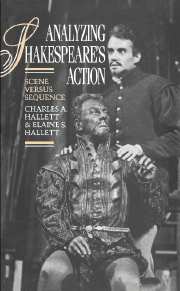Book contents
- Frontmatter
- Contents
- Acknowledgments
- 1 Scene versus sequence in Shakespeare's plays
- 2 The beat defined
- 3 Ancillary beats: the interval beat, the interpolated beat, the linking beat
- 4 Sequential beats: the introductory beat
- 5 Sequential beats: the concluding beat
- 6 Sequential beats: the intensifying beat
- 7 The dramatic question
- 8 Observing and meditating sequences
- 9 Reporting and interrogating sequences
- 10 Persuading sequences
- 11 Disputing sequences
- 12 Commanding sequences
- 13 Sequences combined: the frame
- Notes
- Glossary
- Index of sequences analyzed
- General index
1 - Scene versus sequence in Shakespeare's plays
Published online by Cambridge University Press: 04 August 2010
- Frontmatter
- Contents
- Acknowledgments
- 1 Scene versus sequence in Shakespeare's plays
- 2 The beat defined
- 3 Ancillary beats: the interval beat, the interpolated beat, the linking beat
- 4 Sequential beats: the introductory beat
- 5 Sequential beats: the concluding beat
- 6 Sequential beats: the intensifying beat
- 7 The dramatic question
- 8 Observing and meditating sequences
- 9 Reporting and interrogating sequences
- 10 Persuading sequences
- 11 Disputing sequences
- 12 Commanding sequences
- 13 Sequences combined: the frame
- Notes
- Glossary
- Index of sequences analyzed
- General index
Summary
In the lexicon of dramatic terms the word scene has great authority. Yet, like many terms used with reference to Shakespeare's plays (tragedy, for example, or action), the term scene has never been anchored to a single, easily definable entity. Because the clearing of the stage normally signals a change of setting, people usually define the scene as a temporal/spatial unit. For Mark Rose, the scene is any unit set apart from other units by “a cleared stage indicating change of place or lapse of time,” wherein “the action is plainly continuous.” But we also use the word scene to describe a unit of action in which tensions build toward a significant moment and then taper off. Distinctions between these two radically opposed senses of the word are generally ignored, so that scene is often assumed to mean both things simultaneously. Since the entities described remain as unlike as they ever were, this seemingly reliable term may distort what it is meant to clarify. It seems imperative therefore to examine our assumptions about the unit we too confidently call Shakespeare's scene.
The purpose of this inquiry is not to mount a tedious attack against the use of scene designations in Shakespeare's texts. Most of the conventional scene designations in Shakespeare represent divisions made in his essentially undivided text by editors from John Heminge and Henry Condell on, for whom the cleared stage is the crucial factor in distinguishing one unit from another. Still, the scene is not merely a creation of Shakespeare's editors.
Information
- Type
- Chapter
- Information
- Analyzing Shakespeare's ActionScene versus Sequence, pp. 1 - 10Publisher: Cambridge University PressPrint publication year: 1991
